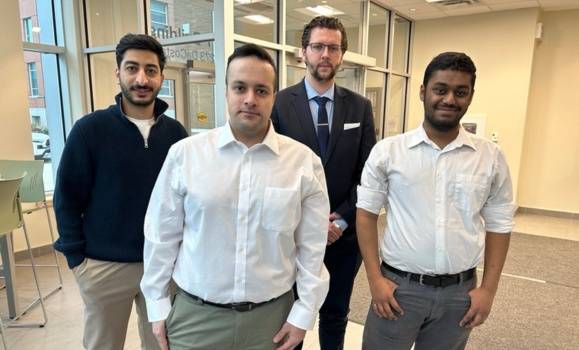The rise of 3D printing has reshaped the landscape of manufacturing and design and brought in a new era of customization and rapid prototyping. Although it has revolutionized industries ranging from healthcare to aerospace, the technology comes with its drawbacks. The vast majority of 3D printers use plastic feedstock which naturally generate a significant amount of plastic waste.
A local clean tech company in Halifax is hoping to change that.
Shifting Shap3s is creating the FilamentPro; a device designed to transform plastic waste into high-quality recycled filament for use in 3D printing. That’s where Dalhousie Chemical Engineering students come in; partnering with Shifting Shap3s to refine the design.
The collaboration is part of Dalhousie Engineering’s Capstone Program; an opportunity that provides all senior year engineering students with the chance to partner with industry on real-world challenges.
Mastering the art of plastic extrusion
For Chemical Engineering student Ben Strange and his teammates, the project involved becoming an expert in “plastic extrusion processes with a focus on die extrusion.”
“So what we’re trying to do hasn’t really been done before,” says Strange. “There’s quite a lot of design work out there already on many different extruders, but there hasn’t been any really that have focused on using waste product or impure feedback.”
To succeed, his particular portion of the Capstone project involves “mastering the use of complex finite element analysis software to simulate dynamic three-dimensional heat and mass transfer extrusion processes involving polymers,” he explains.
What does that mean? It’s understanding how to turn plastic into practical shapes through the utilization of extrusion machines, and mastering computer software for simulating the flow of heat and materials within these mechanisms. To put it simply, it’s like learning how to cook a complex recipe perfectly every time, but with plastic waste instead of food.
“We used a finite element analysis modeling software that models the fluid flow and heat transfer in three dimensions and allow you to see profiles of what the inside of your extrusion die looks likes,” says Strange. “Pressure, temperature, velocity, gradients, and it also does geometric predictive modeling, so I can see what the filament looks like when it comes out of the extruder.”
In a typical design process, the next step would involve building and testing a physical prototype.
“The most challenging part of my capstone project has certainly been the requirement to design an almost completely virtual prototype,” says Strange. “Traditionally extrusion processes, and in particular die extrusion, is designed using limited theoretical work followed by extensive physical prototyping and testing. Since this option was not feasible, our team needed a creative solution in order to complete our project.”
Learning beyond the classroom
For Strange and his team, the experience was all part of the incredible Capstone Program journey. The program not only helps students bridge the theoretical knowledge learned in the classroom with the practical skills required in the engineering professions, but it also challenges them to think outside of the box.
“I needed to fill in the gaps in my own knowledge when I encountered them,” explains Strange. “Like all novel research, the answers aren’t easily found at the back of a textbook and more often than not, even our faculty advisors didn’t have all the answers.”
He adds that the project also gave him the opportunity to explore other areas of engineering that are not always taught inside the classroom, gain extensive hands-on experience, and improve his ability to design and model complex systems.
“My capstone project has given me invaluable perspective into the business dynamics of start-up companies and all that is involved with designing a project from scratch and preparing to bring it to market,” He says. “I found that when working in a start-up environment you may not always have access to the resources or subject matter expertise that a larger established company would and as such you have to always be ready to adapt and find creative solutions to solve what might at first seem like insurmountable challenges.”
Subscribe to AM Chronicle Newsletter to stay connected: https://bit.ly/3fBZ1mP
Follow us on LinkedIn: https://bit.ly/3IjhrFq
Visit for more interesting content on additive manufacturing: https://amchronicle.com


